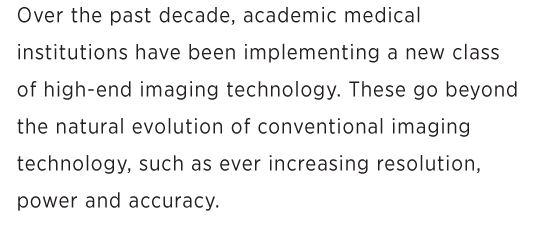
The emphasis has been shifting from equipment that improves traditional techniques, to one that enables new capabilities. Given the high cost of the equipment associated with traditional imaging facilities, there is a natural pressure to use these spaces for clinical purposes, maximizing the number of cases. What is unique about these new types of facilities is the integration of research capability into the clinical realm. The introduction of research functions also enables access to outside funding, such as research grants from the National Center for Image-Guided Therapy (NCIGT), which is NIH’s central resource for all aspects of research into image-guided procedures.
This new type of imaging facility, integrating clinical and research functions, is driven by new programmatic initiatives, including: the development,https://www.PAYETTE.com/wp-admin/media-upload.php?post_id=6319&type=image&TB_iframe=1 testing and refinement of innovative surgical techniques; the invention of new image-guided therapies; the reengineering of surgical implants, devices and the creation of new translational settings required to accommodate a new generation of multidisciplinary teams.
New imaging suites serve the dual purpose of a state-of-the-art clinical environment and high-end research laboratory. They are medical and surgical research environments, housing a vast array of advanced imaging equipment and interventional surgical systems. Multidisciplinary teams of specialists use this equipment array to efficiently and precisely guide treatment — before, during and after surgery — without the patient or medical team ever leaving the operating room. These operating and imaging research suites encourage collaboration among multidisciplinary teams of surgeons, interventional radiologists, imaging physicists, computer scientists, biomedical engineers, nurses and technologists.
In order to accommodate this integration, a new type of facility is needed. PAYETTE has been leading the way with several projects that push the envelope along this new path.
Earlier this year, the Advanced Multimodality Image Guided Operating (AMIGO) Suite was completed at Brigham and Women’s Hospital. The 5,700 square foot suite consists of three separate yet integrated procedure rooms: MRI Room, Operating Room and PET/CT Room. The Suite is designed so that multidisciplinary medical teams can move effortlessly throughout to access any of the advanced imaging and surgical technologies available, whether before, during, or after the procedure. AMIGO is one of the first operating suites in the world to integrate the use of this wide variety of advanced imaging technologies, including cross-sectional digital imaging systems such as CT and MRI; real-time anatomical imaging; and molecular imaging, such as beta probes, PET/CT, and targeted optical imaging. Physicians use the suite to incorporate research protocols designed to enhance standard clinical procedures and to develop new therapeutic approaches, including image-guided therapy in open brain surgery, radiation treatment of prostate cancer and gynecological tumors, breast conserving therapy, MRI-guided cryoablation, treatment of cardiac fibrillation and brain tumor laser ablation.
At Dartmouth-Hitchcock Medical Center, the new seminal 14,000 square feet Advanced Surgery Center and Clinical MRI Addition will open in the spring of 2013. This facility will utilize image-guided precision surgery for multimodal research initiatives. Imaging and surgical space will be used for both clinical procedures and translational research on humans as well as on animal research subjects in a single multi-functional inter-operative suite. Clinicians and researchers will have access to both a ceiling mounted movable MRI and a first-of-its-kind ceiling mounted CT scanner from a single operating room. Furthermore, provisions have been made to integrate future angiography. Intensive logistical planning and utility support have been built in to accommodate future research modalities. The immediate goal of this facility is to offer the potential to improve and develop new surgical procedures, especially in the field of orthopedics, cardiology and oncology

This article appeared in our Winter 2013 Newsletter. Download the complete newsletter here.


